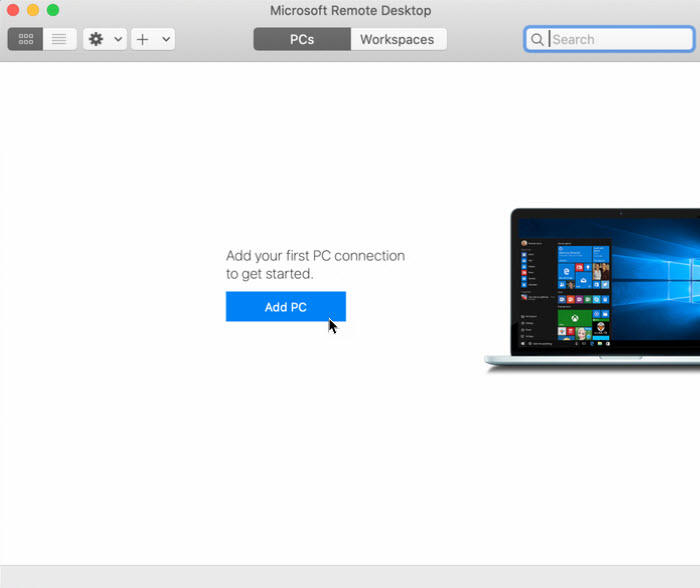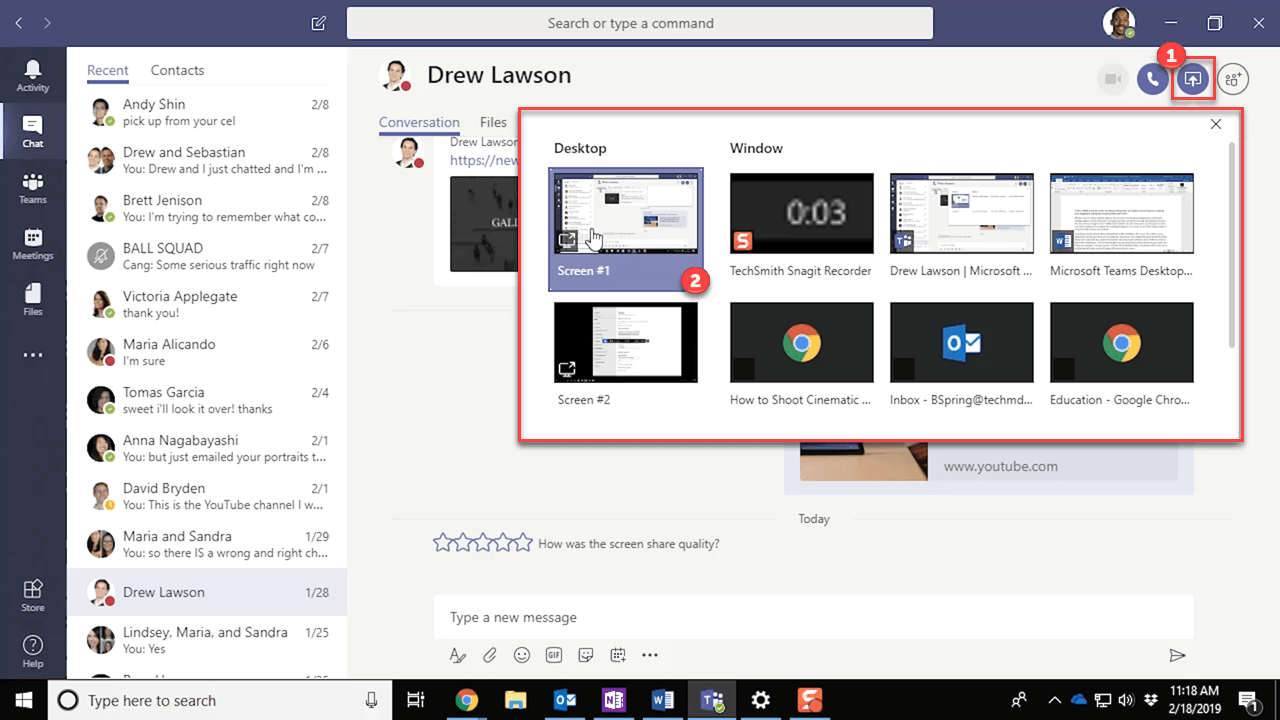Mar 23, 2021 Watch the Meetings videos to learn how to use meetings in Teams. Additional resources for supporting remote workers. Read the FAQ: Support your remote workforce, which we're updating regularly. Use Advisor for Teams to help you roll out Teams. Advisor for Teams (in the Teams admin center) walks you through your Teams deployment. Teams audio (input and output) not working with Remote Desktop, audio input/output in other apps OK by Aaapo on November 04, 2020 16154 Views.
Remote desktop software needs to be understood by end-users the administrator is assisting. Easy setup and navigation is a must for remote desktop software. Start a Remote Desktop software comparison. Pricing Information. While there is free remote desktop software on the market, they are not geared towards larger businesses and enterprises. We use Microsoft Remote Desktop Connection ver. 10.0.18362 to connect to our desktop pcs running on windows 10 1909. When we run Teams from the remote computer, it will not find the built-in webcam from any laptop. It will, however, work if the local computer uses an external usb webcam.
-->Important
Media optimization for Teams is supported for Microsoft 365 Government (GCC) and GCC-High environments. Media optimization for Teams is not supported for Microsoft 365 DoD.
Note
Media optimization for Microsoft Teams is only available for the Windows Desktop client on Windows 10 machines. Media optimizations require Windows Desktop client version 1.2.1026.0 or later.
Microsoft Teams on Windows Virtual Desktop supports chat and collaboration. With media optimizations, it also supports calling and meeting functionality. To learn more about how to use Microsoft Teams in Virtual Desktop Infrastructure (VDI) environments, see Teams for Virtualized Desktop Infrastructure.
With media optimization for Microsoft Teams, the Windows Desktop client handles audio and video locally for Teams calls and meetings. You can still use Microsoft Teams on Windows Virtual Desktop with other clients without optimized calling and meetings. Teams chat and collaboration features are supported on all platforms. To redirect local devices in your remote session, check out Customize Remote Desktop Protocol properties for a host pool.
Prerequisites
Before you can use Microsoft Teams on Windows Virtual Desktop, you'll need to do these things:
- Prepare your network for Microsoft Teams.
- Install the Windows Desktop client on a Windows 10 or Windows 10 IoT Enterprise device that meets the Microsoft Teams hardware requirements for Teams on a Windows PC.
- Connect to a Windows 10 Multi-session or Windows 10 Enterprise virtual machine (VM).
Install the Teams desktop app
This section will show you how to install the Teams desktop app on your Windows 10 Multi-session or Windows 10 Enterprise VM image. To learn more, check out Install or update the Teams desktop app on VDI.
Prepare your image for Teams
To enable media optimization for Teams, set the following registry key on the host:
From the start menu, run RegEdit as an administrator. Navigate to HKEY_LOCAL_MACHINESOFTWAREMicrosoftTeams. Create the Teams key if it doesn't already exist.
Create the following value for the Teams key:
| Name | Type | Data/Value |
|---|---|---|
| IsWVDEnvironment | DWORD | 1 |
Install the Teams WebSocket Service
Install the latest Remote Desktop WebRTC Redirector Service on your VM image. If you encounter an installation error, install the latest Microsoft Visual C++ Redistributable and try again.
Latest WebSocket Service versions
The following table lists the latest versions of the WebSocket Service:
| Version | Release date |
|---|---|
| 1.0.2006.11001 | 07/28/2020 |
| 0.11.0 | 05/29/2020 |
Updates for version 1.0.2006.11001
- Fixed an issue where minimizing the Teams app during a call or meeting caused incoming video to drop.
- Added support for selecting one monitor to share in multi-monitor desktop sessions.
Install Microsoft Teams
You can deploy the Teams desktop app using a per-machine or per-user installation. To install Microsoft Teams in your Windows Virtual Desktop environment:
Download the Teams MSI package that matches your environment. We recommend using the 64-bit installer on a 64-bit operating system.
Important
The latest update of the Teams Desktop client version 1.3.00.21759 fixed an issue where Teams showed UTC time zone in chat, channels, and calendar. The new version of the client will show the remote session time zone.
Run one of the following commands to install the MSI to the host VM:
Per-user installation
This process is the default installation, which installs Teams to the %AppData% user folder. Teams won't work properly with per-user installation on a non-persistent setup.
Per-machine installation
This installs Teams to the Program Files (x86) folder on a 32-bit operating system and to the Program Files folder on a 64-bit operating system. At this point, the golden image setup is complete. Installing Teams per-machine is required for non-persistent setups.
There are two flags that may be set when installing teams, ALLUSER=1 and ALLUSERS=1. It is important to understand the difference between these parameters. The ALLUSER=1 parameter is used only in VDI environments to specify a per-machine installation. The ALLUSERS=1 parameter can be used in non-VDI and VDI environments. When you set this parameter, Teams Machine-Wide Installer appears in Program and Features in Control Panel as well as Apps & features in Windows Settings. All users with admin credentials on the machine can uninstall Teams.
Note
Users and admins can't disable automatic launch for Teams during sign-in at this time.
To uninstall the MSI from the host VM, run this command:
This uninstalls Teams from the Program Files (x86) folder or Program Files folder, depending on the operating system environment.
Note
When you install Teams with the MSI setting ALLUSER=1, automatic updates will be disabled. We recommend you make sure to update Teams at least once a month. To learn more about deploying the Teams desktop app, check out Deploy the Teams desktop app to the VM.

Verify media optimizations loaded
After installing the WebSocket Service and the Teams desktop app, follow these steps to verify that Teams media optimizations loaded:
Quit and restart the Teams application.
Select your user profile image, then select About.
Select Version.
If media optimizations loaded, the banner will show you Windows Virtual Desktop Media optimized. If the banner shows you Windows Virtual Desktop Media not connected, quit the Teams app and try again.
Select your user profile image, then select Settings.
If media optimizations loaded, the audio devices and cameras available locally will be enumerated in the device menu. If the menu shows Remote audio, quit the Teams app and try again. If the devices still don't appear in the menu, check the Privacy settings on your local PC. Ensure the under Settings > Privacy > App permissions the setting Allow apps to access your microphone is toggled On. Disconnect from the remote session, then reconnect and check the audio and video devices again. To join calls and meetings with video, you must also grant permission for apps to access your camera.
If optimizations do not load, uninstall then reinstall Teams and check again.
Known issues and limitations
Using Teams in a virtualized environment is different from using Teams in a non-virtualized environment. For more information about the limitations of Teams in virtualized environments, check out Teams for Virtualized Desktop Infrastructure.
Client deployment, installation, and setup
- With per-machine installation, Teams on VDI isn't automatically updated the same way non-VDI Teams clients are. To update the client, you'll need to update the VM image by installing a new MSI.
- Media optimization for Teams is only supported for the Windows Desktop client on machines running Windows 10.
- Use of explicit HTTP proxies defined on an endpoint is not supported.
Calls and meetings
- The Teams desktop client in Windows Virtual Desktop environments doesn't support creating live events, but you can join live events. For now, we recommend you create live events from the Teams web client in your remote session instead.
- Calls or meetings don't currently support application sharing. Desktop sessions support desktop sharing.
- Give control and take control aren't currently supported.
- Teams on Windows Virtual Desktop only supports one incoming video input at a time. This means that whenever someone tries to share their screen, their screen will appear instead of the meeting leader's screen.
- Due to WebRTC limitations, incoming and outgoing video stream resolution is limited to 720p.
- The Teams app doesn't support HID buttons or LED controls with other devices.
- New Meeting Experience (NME) is not currently supported in VDI environments.
For Teams known issues that aren't related to virtualized environments, see Support Teams in your organization.
Collect Teams logs
If you encounter issues with the Teams desktop app in your Windows Virtual Desktop environment, collect client logs under %appdata%MicrosoftTeamslogs.txt on the host VM.
If you encounter issues with calls and meetings, collect Teams Web client logs with the key combination Ctrl + Alt + Shift + 1. Logs will be written to %userprofile%DownloadsMSTeams Diagnostics Log DATE_TIME.txt on the host VM.
Contact Microsoft Teams support
To contact Microsoft Teams support, go to the Microsoft 365 admin center.
Customize Remote Desktop Protocol properties for a host pool
Customizing a host pool's Remote Desktop Protocol (RDP) properties, such as multi-monitor experience or enabling microphone and audio redirection, lets you deliver an optimal experience for your users based on their needs.
Enabling device redirections is not required when using Teams with media optimization. If you are using Teams without media optimization, set the following RDP properties to enable microphone and camera redirection:
audiocapturemode:i:1enables audio capture from the local device and redirects audio applications in the remote session.audiomode:i:0plays audio on the local computer.camerastoredirect:s:*redirects all cameras.
Running Teams On Remote Desktop
To learn more, check out Customize Remote Desktop Protocol properties for a host pool.

The Windows Remote desktop can be enable with the command line such as CMD and Powershell. Here we enable remote desktop using command prompt in Windows 10. You can use this method on all Microsoft Windows server and Workstation systems.
In Microsoft Windows operating systems, you can connect to a computer running Windows from another computer running Windows that’s connected to the same network or the Internet. For example, you can use all of your work computer’s programs, files, and network resources from your home computer, and it’s just like you’re sitting in front of your computer at work.
To connect to a remote computer, that computer must be turned on; it must have a network connection, Remote Desktop must be enabled. You must have network access to the remote computer (this could be through the Internet), and you must have permission to connect. For permission to connect, you must be on the list of remote desktop users. Before you start a connection, it’s a good idea to look up the name of the computer you’re connecting to and to make sure Remote Desktop connections are allowed through its firewall.
Enable Remote Desktop using Command Line

To enable remote desktop using command line, you must have administrator permission in Windows. The command line interfaces, command prompt or Powershell, must run as administrator.
Enable remote desktop process:
Remote Desktop On Microsoft Teams
- Run Windows Command Prompt.
- Execute registry command to enable remote desktop.
- Enable Remote Desktop on system Firewall.
- Test Remote Desktop Connectivity between two systems.
Let’s run the command prompt as administrator and follow the article to enable remote desktop with command line.
1. Type the below command to enable remote desktop.
The result must be the same as above screenshot. If you face any issue while running command, check the command structure and try again.
2. To disable remote desktop, just type the below command and run it.
3. Allow the Remote desktop on your Windows firewall system with netsh command.

Related: Configure Windows IP Address with Netsh
4. Now, you need to add a user account to remote desktop users group. To do this using the “net localgroup” command.
.png)
The username “Shais” has been added successfully to “Remote Desktop Users” group. You can test the remote desktop user members with below command.
That’s all you need to enable remote desktop using command line on any Windows operating systems.
If you want to do all with a graphical interface, follow the below Microsoft step by step guide to enable remote desktop.
Enable Remote Desktop Connection with GUI
To allow remote connections on the computer, you want to connect to:
- Open System by clicking the Start button, right-clicking Computer, and then click Properties.
- Click Remote settings.If you’re prompted for an administrator password or confirmation, type the password or provide confirmation. Under Remote Desktop, select one of the three options.
- Click Select Users.If you’re an administrator on the computer, your current user account will automatically be added to the list of remote users, and you can skip the next two steps.
- In the Remote Desktop Users dialog box, click Add.
- In the Select Users or Groups dialog box, do the following:
- To specify the search location, click Locations, and then select the location you want to search.
- In entering the object names to select, type the name of the user that you want to add, and then click OK.
- The name will be displayed in the list of users in the Remote Desktop Users dialog box. Click OK, and then click OK again.
To look up the computer name of the remote computer:
- On the remote computer, open System by clicking the Start button, right-clicking Computer, and then click Properties.
- Under Computer name, domain, and workgroup settings, you can find your computer name, and it’s full computer name if your computer is on a domain.
To allow Remote Desktop connections through a Windows Firewall:
If you’re having trouble connecting, Remote Desktop connections might be getting blocked by the firewall. Here’s how to change that setting on a Windows PC. If you’re using another firewall, make sure the port for Remote Desktop (usually 3389) is open.
- On the remote computer, click Start and select Control Panel.
- Click System and Security.
- Then click Allow a program through Windows Firewall under Windows Firewall.
- And click Change settings and then check the box next to Remote Desktop.
- Click OK to save the changes.
To set a password for your user account
Microsoft Team Remote Desktop
Your user account must have a password before you can use Remote Desktop to connect to another computer.
- Click Start and select Control Panel.
- Double-click User Accounts.
- Select Change your Windows Password under User Accounts.
- Click Create a password for your account and follow the instructions on the screen.
To start Remote Desktop on the computer, you want to work from:
- Open Remote Desktop Connection by clicking the Start button. In the search box, type Remote Desktop Connection, and then, in the list of results, click Remote Desktop Connection.
- In the Computer box, type the name of the computer that you want to connect to, and then click Connect. (You can also type the IP address instead of the computer name.)
Finally, hope you can enable remote desktop using command line in your network environment.
